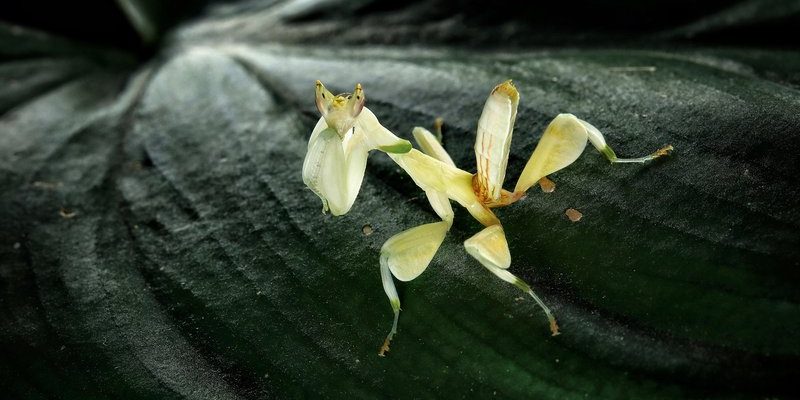
Think about it this way: when you’re in a crowded coffee shop, just nodding your head or raising an eyebrow can say so much without needing to say a word. Mantids use a similar approach. Through body language, pheromones, and even sound, they create a rich tapestry of interactions. Let’s dive into how these remarkable insects engage with each other and their environment!
The Role of Body Language in Mantid Communication
Body language is crucial for mantids, just as it is for us. When you observe a mantis, you’ll see them move with a unique grace, and each posture they adopt tells a story. For instance, when a mantis raises its forearms, it might be readying itself to strike, whether for prey or a potential threat.
– Posture: A mantis that spreads its legs wide and stands tall may be trying to assert dominance over its territory. This is much like when a person takes up more space to convey confidence.
– Color Change: Some mantids can change color to blend into their surroundings or signal themselves as a mate. This display can be compared to someone wearing bright colors at a festival to stand out in the crowd.
Understanding these signals can be essential, especially when you’re observing them in nature. You might be wondering how you could spot these signs if you encountered one. Just look for changes in posture or movement—those are your clues!
Use of Pheromones for Communication
Another fascinating aspect of mantid communication is the use of pheromones. These are chemical signals that they release into the air, which other mantids can detect. This method is especially vital for attracting mates, conveying readiness to breed, or marking territory.
– Mate Attraction: Female mantids release pheromones to attract males during mating season. Imagine it like a perfume scent wafting through the air, leading potential partners to each other.
– Territorial Marking: A mantis might use pheromones to signal ownership of a specific area. This behavior helps avoid unnecessary confrontations with other mantids.
The efficiency of this communication method is astounding. One little drop of pheromone can travel significant distances, drawing potential mates from afar. Think about how surprising it is that such small creatures have developed such an intricate system!
Visual Signals in Mating Rituals
The courtship rituals of mantids are both intricate and mesmerizing. When a male approaches a female, he doesn’t just rush in; there’s a dance of sorts involved.
– Slow Movements: Males typically perform gentle, swaying movements to show they mean no harm. Picture a dance: slow, deliberate steps designed to impress the female rather than startle her.
– Gift Giving: In some species, the male might bring a food offering—a tasty morsel—to woo the female. This act serves two purposes: it demonstrates his fitness as a mate and distracts her for a moment, making it less likely she’ll consider him dinner!
This part of mantid communication is a thrilling example of how complex and strategic these insects can be. Each interaction plays a vital role in their survival.
Sound as a Means of Communication
While mantids aren’t known for loud noises, they do produce sounds that play a role in their interactions. These sounds, often referred to as stridulation, happen when they rub certain body parts together, creating a kind of chirp.
– Warning Calls: Some mantids may produce sounds to warn others of predators or threats nearby. It’s much like an alarm bell going off, prompting alertness in the surrounding area.
– Mating Calls: Just as in other animal species, some males use sound to attract females. This auditory component adds another layer to their communication toolbox.
These sounds can be quite subtle, making it interesting to pay attention when you’re outdoors. Next time you’re observing mantids, listen closely; you might be surprised by what you hear!
Interactions with Other Species
Mantids don’t just communicate among themselves; they also interact with various other species in their environments. This interaction can be quite critical for their survival and overall ecosystem dynamics.
– Predatory Behavior: A praying mantis is a skilled predator and often uses visual cues to stalk and ambush prey. The precision in their movements can be compared to a cat pouncing on its target.
– Coexistence: In some cases, mantids might share their habitat with other insects. They use a mix of body language and pheromones to establish boundaries, ensuring that everyone plays nice—at least most of the time!
Understanding how mantids fit into their ecosystems can help us appreciate the balance of nature. Their interactions showcase the interconnectedness of all living things, no matter how small.
What We Can Learn from Mantid Communication
Studying mantid communication reveals important lessons about connection and interaction. It might surprise you, but their methods can inspire us in numerous ways.
– Non-Verbal Signals: Just like mantids, we often communicate through body language. Recognizing these signals can improve our interactions, making them clearer and more effective.
– Emphasis on Respect: The way mantids approach each other with caution and respect can remind us of the value of patience in our relationships. It’s a great lesson in how we might approach delicate situations, especially when meeting someone new.
By observing how mantids navigate their world, we can find parallels in our lives. It’s fascinating how much depth lies beneath the surface of even the simplest interactions.
Mantids are not just bizarre-looking insects; they are masters of communication and interaction in their unique world. From body language and pheromones to sounds and impressive mating displays, these creatures show us that even the smallest beings have developed complex ways to connect.
Next time you spot a mantis in your garden or on a walk, take a moment to watch its behavior. You might find yourself amazed at how much goes on beneath the surface. Understanding these interactions not only enriches our knowledge of nature but also deepens our appreciation for the intricate web of life we share. So, let’s celebrate the mantids and their remarkable ways of communicating!

